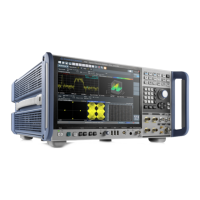Common Measurement Settings
R&S
®
FSW
434User Manual 1173.9411.02 ─ 43
ters. If the selected table is not valid for the selected band, an error message is dis-
played.
If no conversion loss table is available yet, create a new table first (as described in
"To define a new conversion loss table" on page 432).
6. A span is automatically set which covers the whole V band (50 GHz to 75 GHz).
7. Reduce the video bandwidth by selecting "BW > Video Bandwidth Manual": 1
MHz. This allows for correct signal identification using the Auto ID function (see
also "Automatic Signal Identification" on page 414).
8. Select "Basic Settings> Auto ID: On" to activate automatic signal identification.
9. Adapt the tolerance limit by selecting "Basic Settings> Auto ID Threshold". The tol-
erance limit is set to 5 dB in this example.
To take into account the cable loss in the IF path
On performing level correction, the conversion loss of the mixer and also the insertion
loss a
0
of the cable used to tap off the IF signal are to be taken into account. This addi-
tional loss is frequency-dependent.
1. Determine the insertion of the cable at the used intermediate frequency.
2. Increase each reference value in the conversion-loss table by the insertion loss
(a
0
).
a) Select "INPUT > Input Source Config > External Mixer > Conversion Loss
Table".
b) Select the assigned conversion loss table.
c) Select "Edit Table".
d) Select "Shift y" and enter the insertion loss value <a
0
> to shift all y-values in the
table by this value.
3. Select "Save".
Measurement Example 2: Three-Port Mixer with a Large Analysis Bandwidth
The following example demonstrates the operation of an external three-port mixer with
a large analysis bandwidth in the I/Q Analyzer. This example requires the optional
bandwidth extension R&S FSW-B5000. It is assumed that this option has been instal-
led and set up and is ready for use.
(See the R&S FSW I/Q Analyzer and I/Q Input User Manual.)
A broadband 5G-modulated signal with a carrier frequency of 58 GHz is applied. The
spectrum is to be recorded in the range of 52 GHz to 60 GHz using a 3-port mixer for
the V band. The mixer used is an RPG FS-Z75 (new model) double-diode mixer.
Data Input and Output

